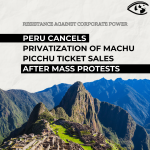ARGENTINA: Kolla Indians Fight to Protect Their Land
"We are here to take care of the land, because we depend on it for a living," said Andrés Sajama, cacique (chief) of Queta, a Kolla indigenous community in the northwestern Argentine province of Jujuy. "We don't want to block mining projects, but we won't allow them to take away what little we have left," he told IPS.
Sajama forms part of the Jujuy Commission of Indigenous Participation (CPI), which won a historic victory in May when the provincial administrative disputes court ordered the state to grant land titles to 120 Kolla communities in the country's Puna plateau region and in the Quebrada de Humahuaca, a long, narrow mountain valley.
The land where the Kolla indigenous people have lived for centuries is coveted by agribusiness concerns keen on extending the agricultural frontier beyond central Argentina to the northwestern part of the country.
Also interested in the land are investors who want to build upscale hotels, and mining companies eager to explore the Puna region and the Quebrada de Humahuaca, where there are deposits of gold, copper and mercury.
La Puna, an arid highland region shared by Argentina and Bolivia and located at 3,500 metres above sea level on average, is bordered on the east by the Quebrada de Humahuaca, which runs north to south. The United Nations Educational, Scientific and Cultural Organisation (UNESCO) added the valley to its list of World Heritage Sites in 2003.
In the Puna region and the Quebrada de Humahuaca, which comprise 80 percent of the provincial territory, more than 20,000 indigenous families grow subsistence crops and raise sheep, goats and llamas.
Up to now, the state had recognised their right to their ancestral land, but land titling efforts have been delayed despite the continuous demands by local indigenous communities.
In 1996, the national government granted the provincial authorities 1.5 million pesos -- equivalent at the time to 1.5 million dollars -- to regularise the land tenure status of the local communities and families. But so far, land titles have only been extended for three plots of land.
In 2003, the CPI filed legal action in the provincial courts to demand that the government immediately fulfill its commitment to legalise the communities' land tenure. But it was not until May that the administrative disputes court set a 15-month deadline for the land titling to be completed.
According to the verdict, the local communities and families have the right to be consulted about initiatives for exploiting the natural resources found in their territory, and to participate in the debates on the projects' environmental impact and on the distribution of the benefits.
The Quebrada de Humahuaca was named a World Heritage Site because it follows the line of a major cultural route, the Camino Inca, and shows substantial archaeological evidence of its use as a major channel for trade over the past 10,000 years. Silver was transported along the route, from what is today Bolivia (to the north) to the RÃo de la Plata or River Plate - separating Argentina and Uruguay - to the south, where it was shipped out to Europe.
According to UNESCO, "It features visible traces of prehistoric hunter-gatherer communities, of the Inca Empire (15th to 16th centuries) and of the fight for independence in the 19th and 20th centuries."
The indigenous people living in the area today are the descendants of the native peoples that formed part of the Inca Empire.
"We are a living heritage of humanity, and they are trying to sell us," Rosario Andrada, a member of the CPI and the leading plaintiff in the land-titling case, told IPS.
"This entire region should be protected," she said, gesturing towards the ochre-coloured hills of the Puna region. "Nevertheless, an investor from Switzerland who shows up with money to build a hotel is allowed to do so without any problem."
"We are not opposed to the mining companies, but we need title deeds to ensure that our children can inherit our land, and to be able to participate in the debate on natural resources," said Sajama.
Indigenous peoples' right to their ancestral land has been enshrined in the Argentine constitution since 1994, and was also mentioned in the May ruling by the provincial administrative disputes court.
According to the 2001 census, indigenous people make up close to four percent of Argentina's population of 37 million.
"The Jujuy provincial government tells us that we are opposed to development. But I ask what development they are talking about when a mining company shows up to mine gold using cyanide, while nearby the children of the Puna region continue to die of malnutrition?" remarked Andrada, the president of the Warmi Sayasjunqo Foundation, a local group of Kolla indigenous women.
Andrada pointed out that the arid land in the Puna region and the Quebrada de Humahuaca is still under the control of the local communities, because the Kolla families "have not left."
"Our grandparents put up with all kinds of abuses and we are not going to leave either. We will continue to defend our right to our land," she said.
But she knows it won't be easy. "In other circumstances, the provincial government would have immediately appealed the verdict. But it so happens that a constitutional reform that would allow the governor to run for reelection is under debate, so the authorities are being careful to avoid unpopular stances that would alienate the poor," said the indigenous activist.
Queta, Sajama's village, is home to 32 families who are praying that the ruling will hold and that they will finally be granted permanent title to their land.
The livelihood of the indigenous people of Queta is based on subsistence agriculture and raising sheep, goats and llamas. In the winter, the temperatures plunge to 15 degrees below zero Celsius. "Now (as the southern hemisphere winter approaches) we are butchering our animals and selling the meat because the pastures have become scarce," said the chief.
There is only a primary school in the village. In order to attend secondary school, Sajama's eight children, aged nine to 24, live on their own 45 km from Queta in a traditional "rancho" or adobe and straw hut in Abra Pampa, the main town in the Puna region.
"There is gold, copper and mercury in our region," said the indigenous leader. "But the mining companies show up with their technology and shortly afterwards our animals start to die, poisoned. How can it be possible that they pollute and carry away the region's wealth, while we are left without even a school for our children to attend?"
Sajama said his mother took part in the "Malón de la Paz" in 1946 -- an indigenous peace march against the exploitative feudal system in the impoverished rural areas of northwestern Argentina.
Back then, indigenous families had to pay large landowners in livestock or labour in order to gain the right to use the land that their communities had lived on for centuries.
They also had to buy their food and other supplies from the landowner's store, and if they were caught with merchandise from another supplier, it was confiscated. Most of the families were caught up in debt bondage, and basically worked as slaves for the local landholders.
But in 1946, the indigenous communities organised, and 174 Kolla Indians from the provinces of Jujuy and Salta set out on a 1,800-km march to Buenos Aires, on foot and by mule, sleeping under the stars. It took them three months to reach the capital.
In Buenos Aires the government made many promises that came to nothing. However, Sajama recalls that the state did reassert control over the land, the landowners were indemnified, the property was divided up, and the indigenous people were granted provisional titles to their ancestral land.
But 60 years later, the Kolla indigenous communities still do not have permanent title to the land where their parents lived, and their grandparents, great-grandparents and great-great-grandparents before them.
- 191 Tourism & Real Estate



